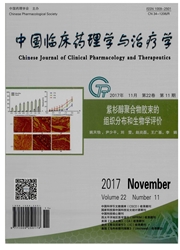

 中文摘要:
中文摘要:
弥漫性胶质瘤是成人中最常见的原发性中枢神经系统肿瘤,分为星形细胞瘤、少突胶质细胞瘤和少突星形细胞瘤,病理级别为Ⅱ-Ⅳ级,其中Ⅳ级的胶质母细胞瘤是最常见的高级别胶质瘤。传统上弥漫性胶质瘤的诊断主要是基于其组织病理学特征,但是仍有很多生物学特点无法很好地解释。而以异柠檬酸脱氢酶(IDH)为代表的生物标志物已被证明对脑胶质瘤分子特征的分类和患者预后情况都有不可忽视的作用。IDH在成人Ⅱ级和Ⅲ级弥漫性胶质瘤及继发性胶质母细胞瘤中突变频率较高。IDH突变的浸润性星形细胞瘤和继发性胶质母细胞瘤具有TP53和ATRX突变的特点。少突胶质细胞瘤也伴随IDH突变并以1p/19q联合性缺失和CIC、FUBP1、Notch1、TERT启动子突变为特征。胶质瘤的生物标志物有望成为临床诊断的新标准。
 英文摘要:
英文摘要:
The diffuse gliomas are the most common primary central nervous system tumors in adults.They are subdivided into astrocytomas,oligodendrogliomas and oligoastrocytomas according to histopathologic features and are graded as grades IIIV.Glioblastoma is the highest grade and most frequent astrocytoma.Biomarkers have been demonstrated that they are important to the molecular classification and prediction of therapeutic response of glioma patients.Isocitrate dehydrogenase( IDH) mutations are frequent in grades II and III diffuse gliomas as well as secondary glioblastoma multiforme,and they are characterized by TP53 and ATRX mutations.The molecular signature of oligodendroglioma includes mutations of IDH,CIC,FUBP1,Notch1 and the TERT promoter together with co-deletion of 1p/19q.As the molecular profiles of gliomas continue to evolve,new guidelines are being proposed to incorporate a tumor 's molecular alterations in to the diagnosis.
 同期刊论文项目
同期刊论文项目
 同项目期刊论文
同项目期刊论文
 Meta-analysis on pharmacogenetics of platinum-based chemotherapy in Non Small Cell Lung Cancer (NSCL
Meta-analysis on pharmacogenetics of platinum-based chemotherapy in Non Small Cell Lung Cancer (NSCL The A/G allele of eIF3a rs3740556 predicts platinum-based chemotherapy resistance in lung cancer pat
The A/G allele of eIF3a rs3740556 predicts platinum-based chemotherapy resistance in lung cancer pat Genetic polymorphism of copper transporter protein 1 is related to platinum resistance in Chinese no
Genetic polymorphism of copper transporter protein 1 is related to platinum resistance in Chinese no Association of Wnt-Inducible Signaling Pathway Protein 1 Genetic Polymorphisms With Lung Cancer Susc
Association of Wnt-Inducible Signaling Pathway Protein 1 Genetic Polymorphisms With Lung Cancer Susc Prediction of copper transport protein 1 (CTR1) genotype on severe cisplatin induced toxicity in non
Prediction of copper transport protein 1 (CTR1) genotype on severe cisplatin induced toxicity in non The ATP7B genetic polymorphisms predict clinical outcome to platinum-based chemotherapy in lung canc
The ATP7B genetic polymorphisms predict clinical outcome to platinum-based chemotherapy in lung canc 期刊信息
期刊信息
